A quote that captures the essence of building rapport with ESL students is as follows:
“Consciously, we teach what we know; unconsciously, we teach who we are.”
Hamacheck (1999, p.209)
I recently watched a video on social media that blew my mind and got me thinking about how important building rapport with our students is. You might have seen the video of a teacher in the US who uses a personalized greeting with each student before they enter the classroom. Each greeting was unique, tailored to the student’s personality and preferences, making each child feel special and recognized. This simple yet powerful gesture set a positive tone for the entire day. Here’s the video:
I would have loved to be one of his students. He truly shows he cares about his pupils. His approach makes each student feel valued and respected. How often do we as teachers go the extra mile to make our students feel this way?
He goes on to say:
“We pride ourselves on high expectations and in meaningful relationships. It’s more than a handshake; it’s about impacting the student in the most positive way.”
This highlights that rapport is not just about friendly gestures but about fostering an environment where students feel genuinely supported and encouraged.
Never underrate the value of relationships with anyone.
So what can a gesture like that teach us? Do we have to teach a morning routine and remember 40 different greetings by heart to build rapport with students?
My answer would be “not quite” (obviously), but there’s much more that lies in that gesture, and I think that shouldn’t go unnoticed. It shows the importance of recognizing each student as an individual and the impact that small, consistent actions can have on building a positive classroom atmosphere. When students feel acknowledged and appreciated, they are more likely to engage and participate actively in their learning.
What does building rapport with ESL students involve?
First, let’s clarify what rapport is. Rapport is the friendly relationship where people understand each other’s feelings or ideas and communicate well. As Jim Scrivener (2005) pointed out, while rapport is crucial, it’s also tricky to define and measure. Once I heard someone saying that building rapport is like tuning a radio to the right station, ensuring you connect on the same frequency. I agree with it.
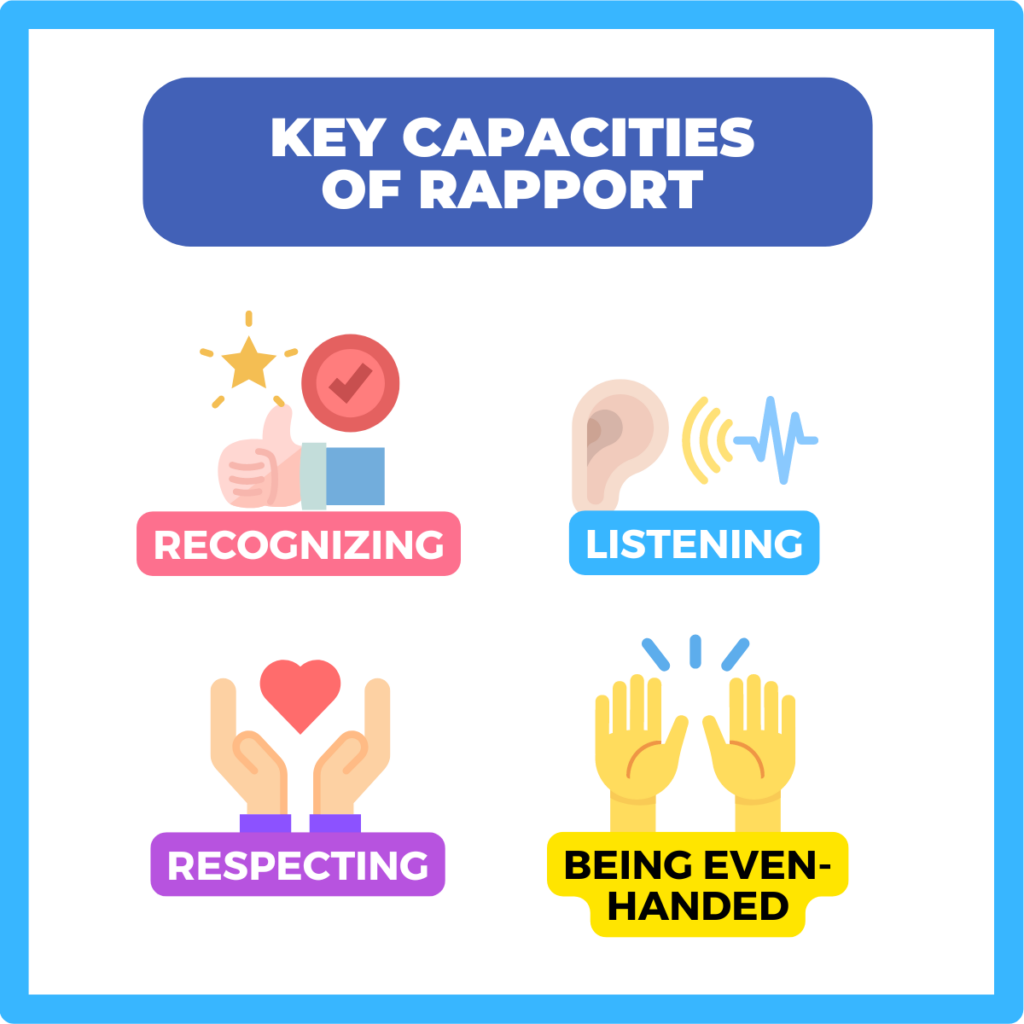
Building rapport with ESL students, especially international students, involves understanding and respecting their unique cultural backgrounds. It’s about creating a safe space where they feel comfortable expressing themselves and making mistakes as they learn.
Jeremy Harmer (2008) identifies four key capacities that make up rapport:
- Recognizing students (including their names)
- Listening to students
- Respecting students
- Being even-handed
Now, let’s see how we can develop these capacities in practical ways.
1. Recognizing students (more than just names!)
First of all, knowing your students’ names is the first step in building rapport. But it’s more than that. For instance, consider Maria, a lively and motivated student in her late 20s who attends private classes twice a week at 9 PM. She’s learning English to boost her confidence at work and make the most of her travels. Due to her job, she often misses classes and wants to make up for them. Recognizing Maria’s dedication despite her hectic schedule shows you understand and respect her efforts. So, always acknowledge their hard work and flexibility.
2. Listening to students
You know, listening actively involves more than just hearing words; it’s about understanding the emotions and intentions behind them. Take Marcelo, a mid-teen student in a language school. He’s intelligent but disengaged due to bullying by peers, compounded by his parents’ recent divorce. By really listening attentively to Marcelo, you can identify his reluctance to participate and address it empathetically. How often do we truly listen to understand rather than just to respond?
3. Respecting students
So, respect is crucial in building rapport. Show respect by appreciating the diverse backgrounds your students come from. Avoid jumping to conclusions based on your frame of reference. For example, if a student has a different opinion about a political figure like Donald Trump, respect their perspective and use it as a learning opportunity. This is a two-way street. There’s no room for judgemental messages or opinions from us.
I love tackling PARNIPS issues. Showing respect is my number one rule for creating an unthreatening and supportive environment amongst my students. Remember that each student brings a unique perspective to the classroom. How can you use these diverse viewpoints to enrich your lessons?
4. Being even-handed

When was the last time you ensured that all your students had an equal opportunity to speak or participate? Honestly, fairness and consistency in treatment help build trust. Ensure all students have equal opportunities to participate and succeed. This approach fosters a supportive environment where everyone feels valued. Reflect on how being fair in your classroom can impact your students’ trust and willingness to engage.
What additional strategies can we use for building rapport with ESL students?
Let’s look at some actionable strategies.
1. Plan engaging activities
Design activities that align with your students’ interests. For instance, if your student loves traveling, you could plan or use lessons on travel or tourism related topics and real-life scenarios. This not only makes learning more enjoyable but also shows that you care about their interests. Conducting a needs analysis at the beginning of the course is crucial. It helps you understand what your students want to achieve and what topics they find interesting.
By understanding their goals and interests, you can tailor your lessons to meet their needs. For example, if you have a student interested in cooking, you could include cooking-related vocabulary and activities in your lessons. Or if your student wants to focus solely on their business skills, you can plan or use some engaging Business English activities for them. This personalization makes the learning experience more relevant and engaging for your students.
Sometimes, it’s also good to give students options and get suggestions from them about the lesson content. This involvement makes them feel valued and more invested in the learning process. How often do you ask your students what they want to learn about today? This simple question can lead to more dynamic and interactive lessons.
2. Learn names quickly
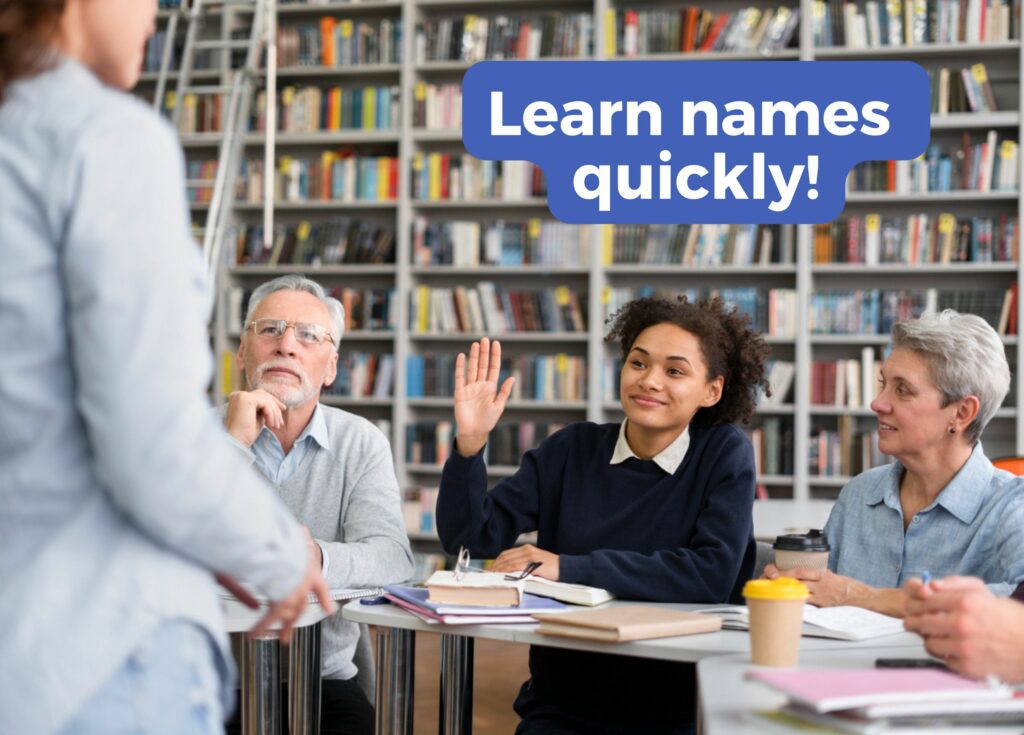
Make an effort to learn and correctly pronounce your students’ names as soon as possible. It shows respect and helps you connect with them on a personal level. I remember the frustration of being called “Celia” instead of Cecilia; it felt impersonal and dismissive.
When teaching international ESL students, it’s especially important to get their names right. Ask your students to teach you the correct pronunciation and practice it.
You might even write it down phonetically to help you remember. This small effort can make a big difference in how students perceive you.
For international ESL students, hearing their names pronounced correctly by their teacher is a sign of respect and acknowledgment. It shows that you care about their identity and are making an effort to connect with them. This can significantly boost their confidence and comfort in the classroom. It’s a simple strategy too for building rapport with ESL students.
3. Set clear and consistent rules
Having clear expectations helps students feel secure. Consistency in enforcing these rules ensures that everyone is treated fairly, which is crucial for building trust. Establish classroom rules and be clear and consistent about your expectations.
Setting clear rules from the beginning creates a structured environment where students know what is expected of them. This clarity helps prevent misunderstandings and ensures that everyone is on the same page.Do you have a set of classroom rules that you share with your students on the first day? How do you ensure that these rules are understood and followed consistently?
4. Show non-verbal care

Non-verbal communication, such as smiling, making eye contact, and using gestures, is a key strategy for building rapport with ESL students. These actions demonstrate warmth and approachability. I always greet my students with a smile to show how happy I am to be there with them – be the lesson online or face-to-face. For example, when a student walks in looking a bit down, a smile and a simple, “It’s great to see you today!” can make a huge difference.
Plus, nodding and using hand gestures while students speak can show that you are engaged and interested in what they are saying. Even small actions like giving a thumbs-up or pat on the back can convey support and encouragement. These non-verbal cues help create a positive and welcoming atmosphere in the classroom.
5. Build empathy by honing your listening skills
Respond to them and try to go beyond “surface mistakes.” Remembering things they have said and cross-referencing students’ contributions can show how much you care beyond classroom observation. What does their body language say? How about their tone of voice? Do they fidget? For instance, if a student mentions feeling nervous about an upcoming test, acknowledge their feelings and offer supportive words or tips to help them prepare.
So, understanding and validating your students’ feelings fosters a supportive environment. Empathy involves seeing things from their perspective and showing that you genuinely care about their experiences and challenges. Remembering things they have said and referring to them in future conversations shows you care. This approach not only builds trust but also helps in creating a more inclusive classroom environment.
6. Praise, feedback, & support

Isn’t it amazing how a little praise can brighten someone’s day? Regular, specific praise helps build students’ confidence. Acknowledge their efforts and improvements, not just their successes. Constructive feedback should be clear and positive, helping them understand how to improve. Praise your students, not only in front of the class, but also privately.
For example, imagine you have a student named Juan who has been struggling with pronunciation. After a few weeks of focused practice, he finally gets it right. Take a moment to say, “Juan, I’ve noticed how hard you’ve been working on your pronunciation. Your improvement is impressive!” Such comments can motivate him to continue his efforts.
Don’t forget, providing him with specific pointers on what he did well and where he can still improve will help him feel supported and encouraged. Juan will certainly remember these special moments.
7. Be genuine and vulnerable
When was the last time you shared something personal with your students? When was the last time you admitted you didn’t know the answer to a question? These moments of honesty and openness can create a strong connection between you and your students. Authenticity goes a long way in building rapport with ESL students. Show your true self, share appropriate personal stories, and admit when you don’t know something. This vulnerability makes you more relatable and trustworthy.
For example, share your travel experiences with your students and listen to their stories as well. If you recently visited a new country, talk about what you learned and ask them about their travel experiences or places they would like to visit. This exchange not only makes lessons more engaging but also builds a bridge of shared experiences. You could even bring in souvenirs or photos to spark conversation and create a more interactive and personal learning environment. By being genuine and open, you show students that it’s okay to be themselves and share their own stories.
8. Get to know ESL students beyond the classroom
Have you ever asked your students about their weekend plans? Take an interest in your students’ lives outside the classroom. Ask about their weekends, plans, and interests. Statements like, “Hi, Daniel, are you okay?” or “How was your weekend?” reflect your sincere interest in their well-being.

Showing interest in their personal lives helps build a strong connection. For instance, if a student mentions they enjoy playing soccer, ask them about their latest game or their favorite team. If another student is into music, inquire about the instruments they play or have a lesson prepared about music and their favorite bands. These conversations show students that you see them as individuals, not just learners.
This approach can lead to deeper discussions and a more trusting relationship. I’m sure your students will appreciate the effort you put into getting to know them and will feel more comfortable and valued in your class.
9. Use social media for engagement
It’s important to note that some contexts, countries, or students don’t allow connecting with students on social media. In these cases, you can create an account for the group on Instagram, Ding, or another platform that is acceptable. Social media can be a great tool to engage students outside lesson times. Encourage them to use platforms like WhatsApp or Facebook for assignments and discussions. Sharing relevant posts or videos can show your students that you think of them beyond the classroom.
For example, if you come across an interesting article related to a topic you discussed in class, share it with your students and ask for their thoughts. This not only keeps them engaged but also reinforces the lesson content. However, be mindful of maintaining professional boundaries and respecting students’ privacy. Ensure that the interactions remain educational and appropriate. Social media can also be used to celebrate students’ achievements by posting about their successes and encouraging positive interactions among peers.
10. Personalize lessons
So, let’s talk about personalization. Tailor your lessons to your students’ lives and interests. Allow them to share their stories and dreams but be mindful not to invade their privacy. This can be as simple as incorporating their hobbies into the lesson plan or discussing topics relevant to their future goals. Personalize the content, but ensure it’s respectful and appropriate.
For example, if you have a student named Sara who is passionate about environmental issues, you could create or use lessons on environmental topics. For example, focus on current environmental news, vocabulary, or discussions on sustainability and how to make a positive impact. This approach makes learning more relevant and engaging for Sara. It shows that you value her interests.
Another scenario could be a student who loves cooking; you could use recipes to teach vocabulary and instructions. By doing this, you make the lesson practical and fun.
All in all, personalizing lessons is a key ingredient for building rapport with ESL students. It helps them see the real-world application of what they learn and keeps them motivated.
11. Use humor and smile when building rapport with ESL students

Do you think humor is necessary in the classroom? You don’t have to be a jester or clown, but a good sense of humor can open doors to your students’ hearts. Use humor to create a relaxed and enjoyable atmosphere. Wouldn’t you feel intimidated if your teacher was serious all the time? Lightening the mood with a joke or a smile can make a big difference.
Humor can break down barriers and make students feel more at ease. For example, if a lesson isn’t going as planned, laughing it off can show students that it’s okay to make mistakes. It also helps create a more dynamic and lively classroom environment. Plus, using humor relevant to the students’ culture and interests can make the lessons more engaging. Imagine a student named Alex who loves to joke around. You could incorporate light-hearted activities or funny examples that resonate with Alex, making the learning experience enjoyable. By embracing humor, you create a positive and inviting classroom atmosphere where students feel comfortable and eager to participate.
Why else does building rapport with ESL students matter?
Building rapport with ESL students is essential for effective teaching. It creates a positive learning environment where students feel respected, understood, and motivated. When students feel this way, they are more likely to engage, participate, and excel both personally and academically. A strong teacher-student relationship can lead to greater personal and academic achievements.
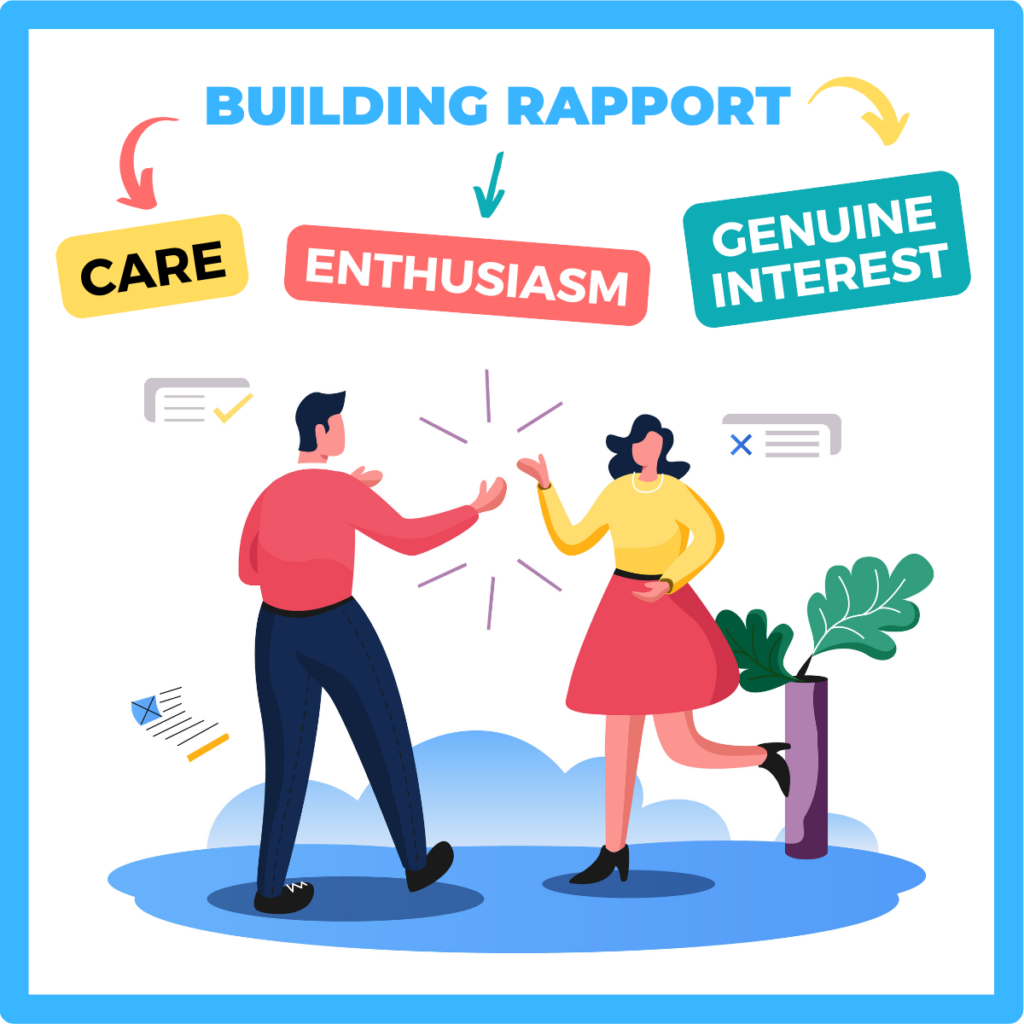
For the past 10 years, my teaching experience has mainly involved one-on-one lessons. I’ve found that the effectiveness of my lessons hinges on the rapport I’ve built with my students. It’s not just about being knowledgeable. It’s about showing care, enthusiasm, and genuine interest in their progress and well-being. Building rapport with ESL students has made a significant difference in my teaching journey.
I remember one private student who didn’t want to engage in small talk or let me get to know her better. Despite trying various strategies, there was no bond between us, making teaching her a drag.
Eventually, I recommended another teacher because the magic of rapport just wasn’t there. This experience taught me that rapport is crucial for a successful teaching relationship. Without it, even the best lesson plans can fall flat.
On the flip side, I’ve had students who started off shy and reserved but opened up over time as we built rapport. One student, named Anna, was initially very quiet. By consistently showing interest in her hobbies and listening to her concerns, she gradually became more engaged and confident in our lessons. This transformation highlighted how building rapport with ESL students can significantly enhance their learning experience.
Final Thoughts on Building Rapport With ESL Students
Building rapport with ESL students is a continuous process that requires patience, empathy, and genuine effort. By recognizing students, listening actively, showing respect, being even-handed, and engaging with their cultures, teachers can create a supportive and inclusive classroom environment. These strategies not only enhance students’ learning experiences but also prepare them to thrive in a diverse world.
Remember, building rapport with ESL students isn’t just a skill; it’s an ongoing journey of connecting, understanding, and growing together. Implement these strategies in your teaching and you’ll see the positive impact it has. By making a consistent effort to build strong relationships, you’ll create a more dynamic and effective learning environment.
For more insights and practical tips on building rapport with ESL students, visit our blog at Fluentize. Happy teaching!


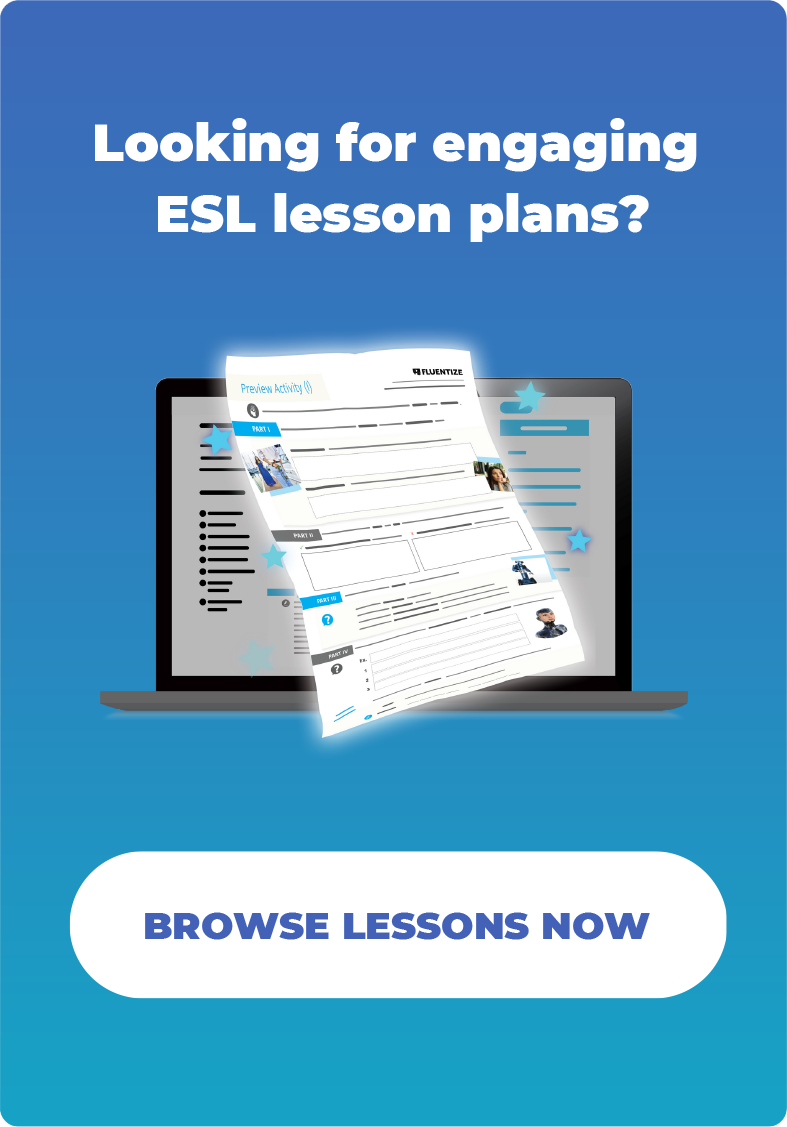
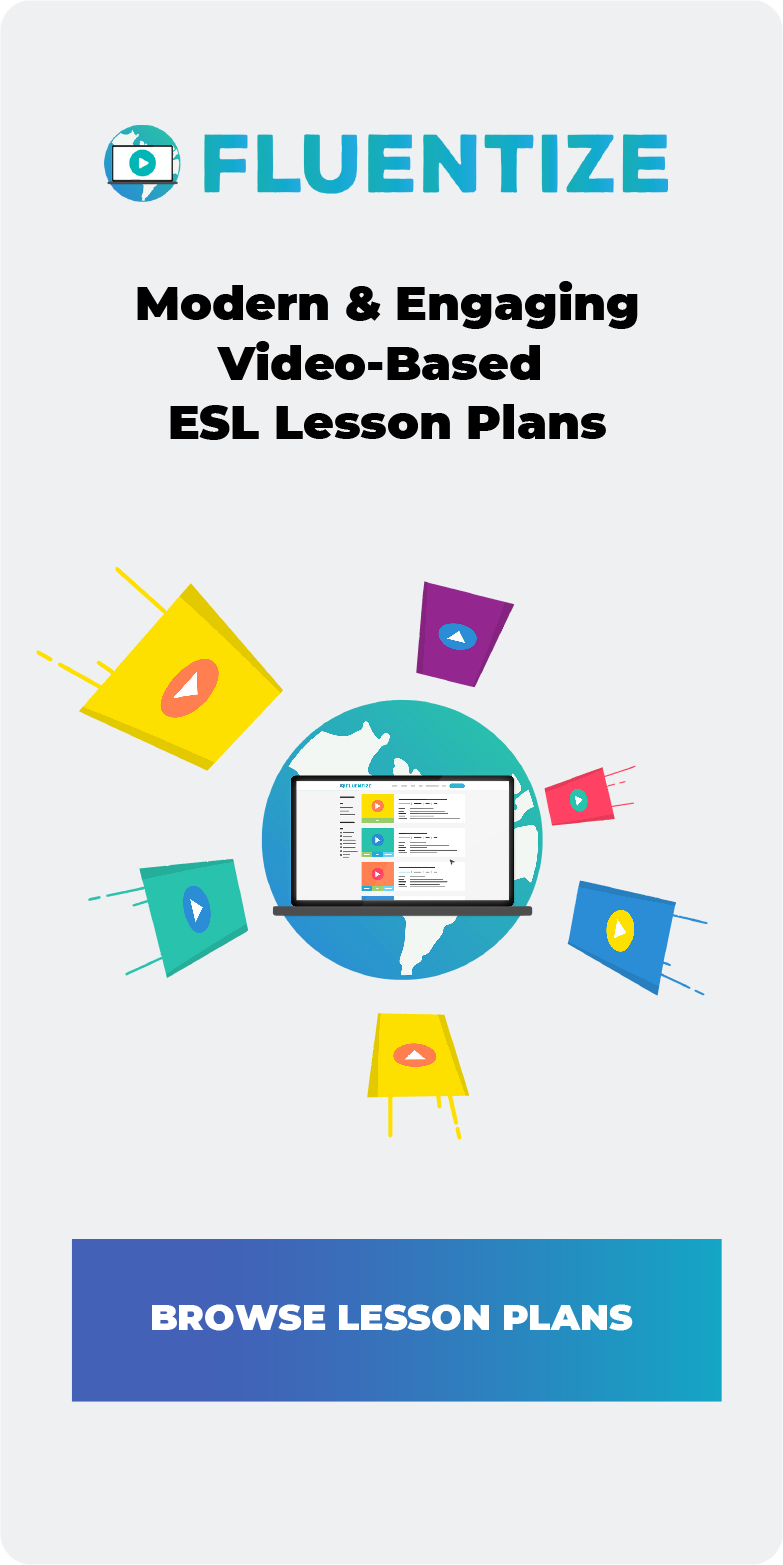






1 thought on “Best Practices For Building Rapport With ESL Students”
What an awesome read! Thanks for sharing your thoughts and experience. It really is heartbreaking to me when international students completely changes their names to make the teacher’s life ‘easier’. To help me remember a name I ask what it means or the reason their families chose that name. Stories can also be a powerful way to remember names..